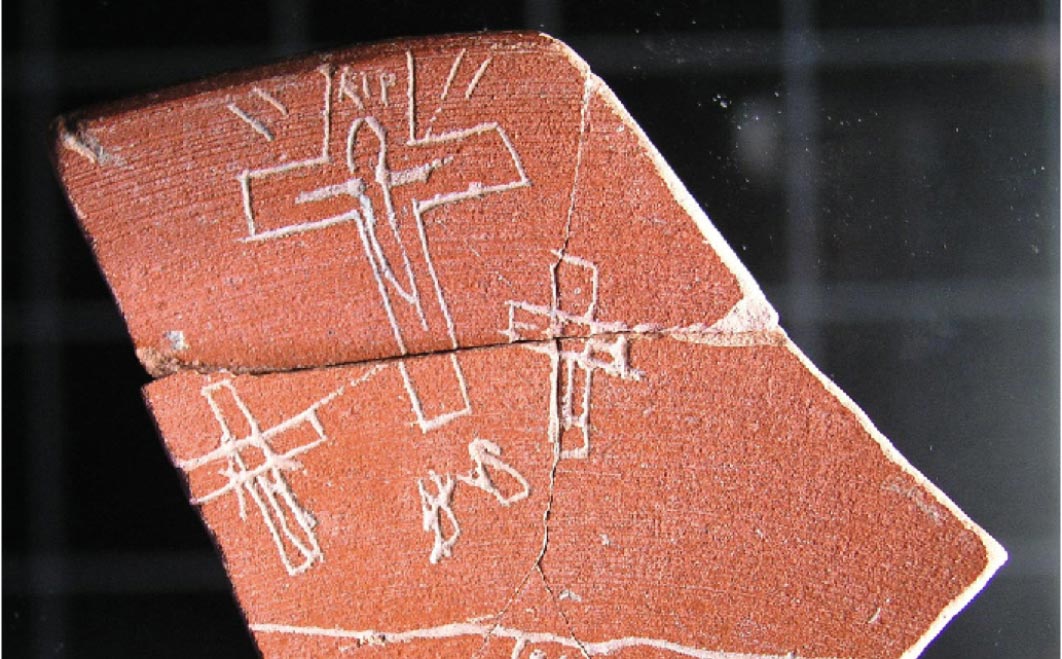Archaeologist Busted for Faking Artifacts Showing Jesus Crucifixion
Archaeologists stand on trial, accused of faking a collection of holy artifacts including the earliest depiction of the crucifixion of Christ.
Archaeologist Eliseo Gil, geologist Óscar Escribano, and materials analyst Rubén Cerdán appeared, this week, in a criminal court in Vitoria-Gasteiz, the capital of Spain's Basque Country. They are accused of having forged ancient graffiti on the faces of hundreds of ancient artifacts.
The Telegraph reported that the three men are charged with having scratched religious images onto pottery, glass, and brick that were subsequently found in the Roman ruins at Iruña-Veleia, about 6 miles (10 kilometers) west of Vitoria-Gasteiz. Gil had boldly claimed the graffiti found on the artifacts demonstrated early links between the Roman settlement in Spain and the Basque language and he claimed three “crosses” found scratched on a fragment of ancient pottery were the earliest known depiction of the crucifixion of Jesus Christ.

Excavation at Iruña-Veleia. (Jabi Zabala / CC BY-NC-SA 2.0)
However, other archaeologists have pointed out that some of the graffiti was made in modern times.
At Least Try To Get The Period Right
In 2008, a provincial government scientific commission ruled that “476 of the artifacts were manipulated or outright fakes” and declared that Gil and his colleagues had “perpetrated an elaborate fraud”. At the time of the commissions’ report, Gil and his company were stopped from excavation at Iruña-Veleia and charged.
Rodríguez Temiño works in Seville for the provincial government of Andalucía and in 2017 he published a paper in the archaeological journal Zephyrus that detailed evidence that the artifacts from Iruña-Veleia were hoaxes. The trial has now begun.
- Second (Or Third) Ever Skeleton with Evidence of Crucifixion Discovered
- Solid Muldoon: Petrified Prehistoric Man was an Elaborate and Daring Hoax
- The Shroud of Turin: Jesus' Bloodstained Burial Cloth or a Fascinating Forgery?

Archaeologist Eliseo Gil accused of faking Iruña-Veleia artifacts. Source: Noticias de 5 Minutos / YouTube.
Gil had soaked up media attention in Spain's Basque Country in 2006 when according to the archaeologists hundreds of broken ceramic pieces known as “ostraca” showing Egyptian hieroglyphics and drawings and phrases in Latin, Greek, and Basque were unearthed at the Iruña-Veleia site. But the alarm bells began ringing when certain phrases in Latin were found to be “from the wrong period”.
Hundreds Of Years Out…
The graffiti on some of the artifacts apparently spelled out the name of the ancient Egyptian queen Nefertiti, in hieroglyphics, but she would have been unknown until her tomb was discovered in the 20th century. Not to mention one of the fragments of pottery had a Latin motto that had been created around 1913 for an international court at The Hague, in the Netherlands.
Other archaeologists also point to the fact that writings on the artifacts contain words and spellings from hundreds of years later, including modern commas and the mixed use of uppercase and lowercase letters which didn’t occur until about the 18th century. Experts also considered the depiction of the crucifixion portrayed on the most famous artifact had actually been created “hundreds of years later than claimed”.

Uppercase and lowercase letters were used on the Iruña-Veleia artifacts. (Zephyrus)
But facing five and a half years in prison if found guilty of damaging heritage items and fraud, Gil and Escribano claimed they were not guilty of any such deception, while Cerdán faces two and a half years in prison charged with creating fraudulent documents confirming the authenticity of the artifacts.
There Is Always An Element Of Doubt
Doctor in History, specialty Archeology and Sciences of Antiquity, Ignacio Rodríguez Temiño, told Live Science in an email that he has “no doubts about their falsity” and that there is no dispute on the Iruña-Veleia case in the academic world. The prosecution is seeking more than $313,000 (285,000 euros) for damages to what were authentic artifacts from Iruña-Veleia and they've asked the court to jail Gil and his associates, to fine them, and to disqualify them from working at any more archaeological sites.
But without sufficient evidence to tie Gil to the crime, some archaeologists say they don't know if Gil and his associates were directly responsible for the creation of the graffiti. And speaking at a news conference Gil said his ostracism from the archaeological world was “like being tortured” and he maintained his innocence saying “there is no scientific evidence that the artifacts are fake”.
Yup, Gil actually said that, which in my opinion casts him into a darkened social realm populated with folk like ‘holocaust deniers’, who also point out that there is also no scientific evidence proving Hitler killed six million Jews. Also, in that category are religious zealots who claim there is no evidence that God doesn’t exist, and it seems it is this last category of people that the archaeologist was ‘playing’ too.
Rewriting History For Those With No God
Concerning the possible reasons for this archaeological deception, in Rodríguez Temiño’s 2017 paper he said Basque public companies and government bodies awarded Gil and his associates “sponsorships worth millions of dollars” for their work at Iruña-Veleia, which means on one level the scam was a multi-million dollar fraud. But it is also suspected that Gil and his cohorts created the fake artifacts not only to become rich, but to enhance “Basque nationalism”, by demonstrating early usage of their language and the Christianization of the Basque Country, which according to Dr. Temiño are two stories “that a certain segment of Basque society longs to hear”.

Ostracon with text in Basque on one of the Iruña-Veleia artifacts. (Zephyrus)
Top image: One of the Iruña-Veleia artifacts, note the inscription RIP above the main cross. (Zephyrus)
By Ashley Cowie



















